Abstract
Objectives: Drug-drug cocrystals with improved properties can be used to facilitate the development of synergistic therapeutic combinations. The goal of the present study is to obtain novel drug-drug cocrystals involving two anti-glioma agents, temozolomide (TMZ) and myricetin (MYR). Methods: The novel TMZ-MYR cocrystal was prepared via slurry and solvent evaporation techniques and characterized by X-ray diffraction, thermal analysis, infrared spectroscopy, and dynamic vapor sorption measurements. The stability, compaction, and dissolution properties were also evaluated. Results: Crystal structure analysis revealed that the cocrystal lattice contains two TMZ molecules, one MYR molecule, and four water molecules, which are linked by hydrogen bonding interactions to produce a three-dimensional network. The cocrystal hydrate exhibited favorable stability and tabletability compared to pure TMZ. A dissolution study showed that the maximum solubility of MYR in the cocrystal (176.4 μg/mL) was approximately 6.6 times higher than that of pure MYR·H2O (26.9 μg/mL), while the solubility of TMZ from the cocrystal (786.7 µg/mL) was remarkably lower than that of pure TMZ (7519.8 µg/mL). The solubility difference between MYR and TMZ was diminished from ~280-fold to ~4.5-fold. Conclusions: Overall, the TMZ-MYR cocrystal optimizes the stability and tabletability of TMZ and the dissolution behavior of both drugs, offering a promising approach for synergistic anti-glioma therapy with improved clinical potential.
1. Introduction
Pharmaceutical cocrystals assemble active pharmaceutical ingredients (APIs) with pharmaceutically acceptable cocrystal formers (CCFs) at a stoichiometric ratio through non-covalent interactions, forming a new type of homogeneous crystal with unique crystal structures and physicochemical properties []. The cocrystal formation can not only enhance the solubility and dissolution rate of insoluble drugs but also inhibit unstable chemical degradation pathways by altering the molecular stacking patterns, reduce the quality risk of drugs during storage or transportation, and improve the mechanical processing properties of powders to accelerate the development of formulations [,,,,,]. In addition, as new chemical entities, cocrystals can also provide new patent protection for pharmaceuticals and bring great economic benefits for companies []. Drug-drug cocrystals are a branch of pharmaceutical cocrystals, whose core feature is that the CCFs themselves are also APIs with therapeutic value [,]. As compared to physical mixtures or traditional compound preparations, drug-drug cocrystals can not only simplify administration plans and improve patients’ compliance but also effectively improve physicochemical properties and overcome the solubility differences and compatibility issues between different drugs [].
Temozolomide (TMZ, Figure 1) is a first-line drug in the treatment of malignant gliomas with good anti-glioma activity and blood-brain barrier penetration ability []. TMZ is a white to slightly red solid powder with decomposition temperature of 212 °C. The pKa value of TMZ is 14.722 ± 0.20 (predicted). The aqueous solubility and log p value of TMZ are 5 mg/mL and −0.989 (predicted), respectively [,], so it is a BCS Class III drug. It is relatively stable under acidic conditions and undergoes hydrolysis under neutral or alkaline conditions []. TMZ has a rapid rate of elimination in vivo, a property that somewhat diminishes its therapeutic effect []. In addition, TMZ is prone to chemical degradation, resulting in a gradual reduction of its active ingredient and generation of some impurities, which in turn affects the safety and efficacy of the drug. Thus, TMZ faces significant challenges in areas such as production and storage []. Recently, two cocrystals of TMZ with baicalein and hesperetin have been reported and show improved properties as compared to the pristine drugs [,]. These findings inspired us to further explore the potential and possibility of constructing more TMZ cocrystals with flavonoids to offer more options for potential clinical application. Thus, a group of flavonoids with anti-glioma activity, including apigenin, daidzein, morin, myricetin, naringenin, etc. [,,,], were screened. Finally, we successfully obtained a novel drug-drug cocrystal of TMZ and myricetin (MYR, Figure 1).
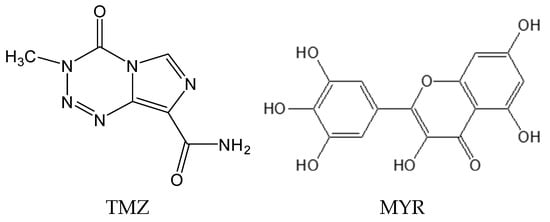
Figure 1.
Chemical structures of TMZ and MYR.
MYR is a natural flavonoid and exhibits anti-glioma activity by blocking lamellipodia formation and suppressing focal adhesions []. Unlike baicalein and hesperetin, which induce glioma cell apoptosis via the reduction of the expression of HIF-1α, VEGF, and VEGFR2 and the activation of p38 MAPK [,], MYR employs a distinct mechanism, making it a promising candidate for combination therapy. MYR is a yellow needle-shaped crystalline powder with a melting point of 357 °C. The pKa value of MYR is 6.3 (experimental). The water solubility of MYR is 17 µg/mL, and its log p value is 1.655 (predicted) [,], thus it is classified as a BCS Class IV drug. MYR’s low bioavailability due to its poor solubility limits its clinical utility []. To address these challenges, we focused on developing a novel TMZ-MYR drug-drug cocrystal. The objective was to optimize the properties of both drugs for synergistic anti-glioma treatment. This study reports the preparation, characterization, and property evaluations of the TMZ-MYR cocrystal. The cocrystal’s crystal structure, moisture sorption behavior, stability, compaction property, and dissolution profiles were systematically investigated to demonstrate its potential as an improved therapeutic formulation for glioma.
2. Materials and Methods
Materials. Temozolomide (TMZ, 98% purity) and myricetin monohydrate (MYR∙H2O, 98% purity) were obtained from Shanghai Shengde Pharmaceutical Science and Technology Co., Ltd. (Shanghai, China). Butanone (analytical grade), acetic acid (analytical grade), sodium chloride (NaCl, analytical grade), and potassium bromide (KBr, spectroscopic grade) were purchased from Fuchen Chemical Reagent Co., Ltd. (Tianjin, China). Hydrochloric acid (analytical grade) was supplied by Sinopharm Chemical Reagent Co., Ltd. (Shanghai, China). Tween 80 (pharmaceutical grade) was acquired from Shanghai Macklin Biochemical Co., Ltd. (Shanghai, China). Anhydrous methanol (chromatographic purity), used as the eluent in HPLC analyses, was purchased from Tianjin Saifurui Technology Co., Ltd. (Tianjin, China). All chemicals and solvents were used as received without further purification.
Preparation of Cocrystal, 2TMZ/MYR·4H2O (2:1:4). The cocrystal was prepared by two methods as follows: (I) TMZ (0.4 mmol, 77.6 mg) and MYR∙H2O (0.2 mmol, 63.6 mg) were accurately weighed into a 10 mL Eppendorf tube and 1 mL of water was added. The reaction was carried out on a magnetic stirrer (RCT D S025, IKA, Staufen, Germany) at a stirring rate of 500 rpm for 12 h. At the end of the reaction, the suspension was filtered by a filter (SHB-Ⅲ, Tianjin Kenuo Instrument and Equipment Co., Ltd., Tianjin, China) and the filter cake was allowed to dry under vacuum for 48 h. The cocrystal powder (130.0 mg) was obtained in 92.07% yield. (II) Excess of cocrystal powder was placed in 2 mL of butanone and processed using an ultrasonic instrument (KS-040AL, Shenzhen Jiekang Cleaning Electrical Appliance Co., Ltd., Shenzhen, China) at room temperature for 20 min to fully mix and dissolve. The resulting solution was filtered through a 0.22 μm organic nylon filter, and the filtrate was transferred to a clean high-borosilicate glass beaker, which was then sealed with Parafilm. After one week, needle-like crystals were obtained.
Single-Crystal X-ray Diffraction. Single crystals of 2TMZ/MYR·4H2O were mounted on an Agilent Technologies Gemini A Ultra system and irradiated with monochromated Cu Kα radiation (λ = 1.54178 Å) at 293(2) K. Cell refinement and data reduction were conducted with the CrysAlisPro software ver.1.171.44.91a []. The crystal structure was solved by the direct method using SHELX-97 [] and refined by full-matrix least squares on F2 with Olex2 ver. 1.5. Non-hydrogen atoms were refined with anisotropic displacement parameters. Hydrogen atoms were placed in geometrically idealized positions and refined using a riding model.
Powder X-ray Diffraction (PXRD). PXRD measurement was conducted on a Rigaku MiniFlex 600 X-ray diffractometer (Rigaku, Akishima-shi, Japan) with Cu Kα radiation (λ = 1.541862 Å) as a light source. The voltage and current were 40 kV and 15 mA. The step size and scanning speed were set as 0.01°/step and 0.1 s/step, and the scanning range was set as 5–40°. The data collection and processing were conducted using SmartLab Studio II software ver. 4.3.287.0.
Thermogravimetric (TG) Analysis. TG analysis was conducted using a Netzsch TG 209 F3 analyzer (Netzsch, Selb, Germany) from 40 to 500 °C at 10 °C/min. Both the purge gas and protective gas were nitrogen, with flow rates of 50 mL/min and 20 mL/min, respectively. Samples (5–10 mg) were placed on alumina crucibles, and data collection and processing were conducted using NETZSCH Proteus thermal analysis software ver. 7.1.0.
Differential Scanning Calorimetry (DSC). DSC measurements were performed using a Netzsch DSC 200 F3 instrument (Netzsch, Selb, Germany) from 30 °C to the decomposition temperature of each sample (206 °C for TMZ, 350 °C for MYR∙H2O, 300 °C for the cocrystal) at 10 °C/min in a nitrogen atmosphere. Samples (5–10 mg) were sealed in aluminum pans, and data collection and processing were conducted using NETZSCH Proteus thermal analysis software ver. 7.1.0.
Fourier Transform Infrared (FTIR) Spectroscopy. FTIR spectra were acquired on a BRUKER VERTEX 70 spectrometer (Bruker, Karlsruhe, Germany) using the KBr pellet method. The mass ratio of powder sample to dried KBr is 1:100. For sample preparation, the sample and KBr were ground uniformly in a mortar, then pressed into a transparent pellet using a tablet press under a pressure of 1.0 t for 2 min, which was subsequently used for analysis. Spectra were scanned over the range of 4000 to 500 cm−1 with 64 scans and a resolution of 0.2 cm−1. Data collection and processing were performed using Spectrum software ver. 10.4.4.449.
Dynamic Vapor Sorption (DVS) Study. A DVS study was performed on a DVS intrinsic instrument (Surface Measurement Systems, London, UK) at 25 ± 0.1 °C. Sieved samples (75–150 μm) were exposed to a humidity gradient from 0% to 95% RH and back to 0%, in 10% RH steps. Weight changes were recorded to evaluate moisture sorption behavior. The instrument was controlled using DVS Intrinsic Control Software ver. 1.0.3.1, and data processing was conducted using the Isotherm (ISO) analysis suite.
Accelerated Stability Test. The samples of the cocrystal and TMZ were weighed into open vials and then stored in a stability chamber (Memmert, Schwabach, Germany) at 40 °C. A relative humidity of 75% was maintained using a sealed desiccator containing a saturated NaCl solution. Samples were analyzed at 0, 1, 2, and 3 months using PXRD and HPLC to monitor phase purity and TMZ content. Visual inspection was performed to assess physical changes.
Powder Compaction Experiment. Powder compaction properties of 2TMZ/MYR·4H2O, pure TMZ, and MYR·H2O were evaluated using a reported method []. Powder compaction was performed using a hydraulic press (Specac GS01190, New York, NY, USA) at pressures from 50 to 300 MPa with a 5 mm die. The tablet breaking force was tested by an intelligent tablet hardness analyzer (YD-20KZ, TDTF, Tianjin, China). Tablet tensile strength (σ) was calculated using Equation (1),
where F is the breaking force, D is tablet diameter, and t is the thickness. Tensile strength measurements were repeated three times to ensure reproducibility. PXRD tests were conducted to detect possible phase changes for the samples compressed under 300 MPa.
Powder Dissolution Experiment. Powder dissolution experiments of 2TMZ/MYR·4H2O, pure TMZ, and MYR·H2O were carried out according to a reported method []. The drug dosage used in the dissolution experiments was equivalent to 700 mg TMZ and 574 mg MYR. The dissolution experiments were conducted in a paddle apparatus with 45 mL of pH 1.2 HCl containing 0.1% Tween 80 at 37 °C and 100 rpm. Samples were withdrawn at scheduled time points, filtered, and analyzed by HPLC. Powder dissolution experiments were repeated three times to evaluate standard deviations. After the dissolution experiments, the remaining solids were collected for PXRD analysis.
High Performance Liquid Chromatography (HPLC) Analysis. HPLC analysis was performed following a modified protocol based on previously reported methods []. A Shimadzu LC-2030C 3D Plus HPLC system equipped with a C18 column (Inertsil ODS-3, 5 μm × 4.6 mm × 150 mm column) was utilized. The detection wavelengths were set at 329 nm for TMZ and 375 nm for MYR. The column temperature was maintained at 35 °C throughout the analysis. The mobile phase consisted of a mixture of methanol and an acetic acid solution (adjusted to pH 2.8). Gradient elution was employed with a constant flow rate of 1 mL/min, following the sequence: 10% (v/v) methanol for 7 min, linear increase to 60% (v/v) methanol in 1 min, isocratic elution at 60% (v/v) methanol for 8 min, return to 10% (v/v) methanol over 1.5 min, re-equilibration at 10% (v/v) methanol for 2.5 min. This method enabled the simultaneous quantification of TMZ and MYR in the cocrystal samples, ensuring accurate determination of their concentrations and purity. Data collection and processing were performed using LabSolutions software ver. 5.96.
3. Results and Discussion
Cocrystal Preparation. The phase-pure bulk sample of the cocrystal hydrate, 2TMZ/MYR·4H2O, was prepared by a slurry technique. This cocrystal has a unique 2:1 stoichiometric ratio of TMZ and MYR, differing from the 1:1 ratio of previously reported TMZ-flavonoid cocrystals [,]. This distinction provides an additional clinical option for personalized glioma therapy. The high-quality single crystals were obtained via recrystallization in butanone at room temperature, which were essential for subsequent crystal structure analysis.
Crystal Structure Analysis. The crystallographic data and refinement parameters of the cocrystal are summarized in Table 1. Selected hydrogen bonding distances and angles are listed in Table S1. The cocrystal crystallizes in the triclinic space group P-1, showing lattice constants a = 7.4917(5) Å, b = 14.4652(10) Å, c = 15.9455(10) Å, α = 110.295(6)°, β = 100.265(5)°, γ = 90.811(5)° (Table 1). The asymmetric unit contains two TMZ molecules, one MYR molecule, and four water molecules. Hydrogen bonds link one TMZ molecule to one water molecule and MYR to three water molecules (Figure 2a). TMZ and water molecules form a two-dimensional (2D) planar structure via hydrogen bonds (Figure 2b), and MYR also forms another type of 2D hydrogen-bonded plane with water molecules (Figure 2c). These two types of 2D planes then stack in an alternating arrangement via hydrogen bonds and π–π interactions, ultimately constructing a three-dimensional (3D) supramolecular structure (Figure 2d,e).

Table 1.
Crystallographic data and refinement parameters of 2TMZ/MYR·4H2O.

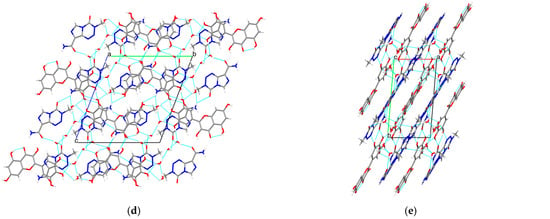
Figure 2.
(a) Asymmetric unit, (b) TMZ sheet, (c) MYR sheet, (d) top and (e) side view of 3D structure of 2TMZ/MYR·4H2O.
Crystal engineering analysis reveals that the parent drug TMZ (reference code DIPGIS10) and MYR·H2O (reference code NIKLAX) both crystallize in the monoclinic P21/c space group [,]. TMZ forms dimers through amide-amide R22(8) double hydrogen bonds (Figure S1a), and four dimers are connected by weak hydrogen bonds to form cyclic nodes (Figure S1b). These nodes periodically assemble into a reticular interwoven framework structure (Figure S1c). Meanwhile, intramolecular hydrogen bonds exist between the carbonyl and adjacent hydroxyl group of the benzene ring in MYR·H2O, and MYR molecules form wavy hydrogen-bonded structures through other hydroxyls on two benzene rings (Figure S2a). These wavy structures stack into a 3D structure via π–π interactions and hydrogen bonds of water molecules (Figure S2b). Cocrystallization retains the amide-amide R22(8) dimer of TMZ and the intramolecular hydrogen bond of MYR, while rebalancing other hydrogen bond donors/acceptors; the crystal packing mode changes from the reticular interwoven framework of TMZ and the wavy stacking of MYR to an alternating layered architecture of TMZ-MYR, thereby affecting the stability, tabletability, and dissolution behavior of the cocrystal.
Hirshfeld Surface Analysis. Hirshfeld surface analysis is a tool for quantifying and visualizing intermolecular contacts []. Based on the single-crystal structures of the cocrystal and its component crystals, Hirshfeld surface analysis was performed. Two-dimensional fingerprint plots are shown in Figure S3, and the relative contributions of various intermolecular contacts are illustrated in Figure 3. For 2TMZ/MYR·4H2O and its component crystals, the main contributions come from H-H, C-H, and O-H contacts, corresponding to van der Waals forces, C-H···π interactions, and hydrogen bonds, respectively. Additionally, pure TMZ and the cocrystal include N-H contacts (Figure 3). Cocrystallization significantly alters the intermolecular interaction patterns. Compared with pure TMZ, the contributions of O-H (26.5%→38.4%) and H-H (18%→30.40%) increase in the cocrystal, reflecting enhanced hydrogen bonding between TMZ and hydrophobic MYR as well as stronger van der Waals forces, which may reduce the solubility of TMZ. For MYR, the cocrystal shows increased contribution N-H (0%→14.5%), while the contribution of C-H (8%→5%) decreases, indicating enhanced hydrogen bonding with hydrophilic TMZ and weakened C-H···π interactions, which may improve the dissolution performance of MYR.
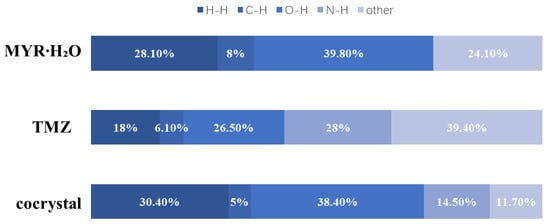
Figure 3.
Percentage contributions of intermolecular interactions for TMZ, MYR·H2O, and 2TMZ/MYR·4H2O.
PXRD Analysis. The experimental PXRD pattern of the cocrystal matched the simulated pattern derived from single-crystal data, confirming its crystalline phase purity. Distinct peaks at 2θ values of 6.5°, 7.1°, 12.1°, 12.3°, 14.5°, 16.2°, 22.2°, 23.4°, 25.1°, 26.6°, and 28.1° were observed, which were absent in the patterns of pure TMZ and MYR·H2O (Figure 4). This result indicates the formation of a new crystalline phase, distinguishing the cocrystal from its parent materials.
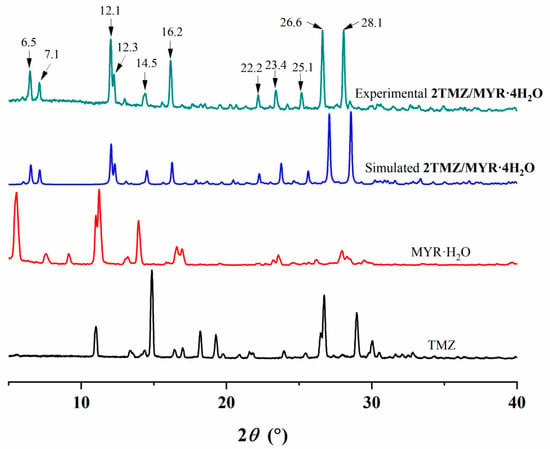
Figure 4.
PXRD patterns of 2TMZ/MYR·4H2O, MYR·H2O, and TMZ.
Thermal Analysis. DSC and TG measurements revealed the thermal behavior of the cocrystal (Figure 5). The TG curve showed a 9.3% weight loss below 120 °C, corresponding to the loss of four water molecules (theoretical 9.25%). The DSC curve exhibited an endothermic peak at 108.2 °C due to dehydration, followed by an exothermic peak at 169.7 °C from TMZ decomposition. In comparison, pure TMZ decomposed with a sharp exothermic peak at 202.2 °C, while MYR·H2O showed dehydration, dehydration-induced phase transition, and melting point with endothermic peaks at 85.9 °C, 104.2 °C, and 312.0 °C, respectively. The thermal analysis suggests that cocrystallization modifies the thermal properties of both drugs, potentially improving their stability during storage and processing.
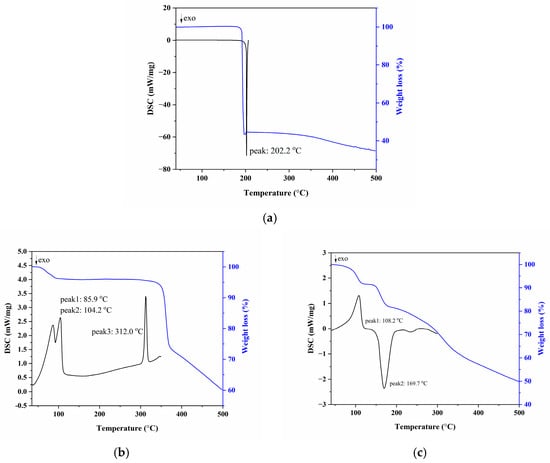
Figure 5.
TG and DSC thermograms of (a) TMZ, (b) MYR·H2O, and (c) 2TMZ/MYR·4H2O.
FTIR Analysis. FTIR spectra can be used to confirm the formation of hydrogen bonds in the cocrystal. The FTIR spectra of TMZ, MYR·H2O, and 2TMZ/MYR·4H2O are provided in Figure 6. For pure TMZ, the characteristic peaks presented at 3421 and 3388 cm−1 are attributed to the stretching vibrations of the N−H bond, and the C=O stretching vibrations appeared at 1759 and 1733 cm−1 []. MYR·H2O showed characteristic peaks at 1606, 1660 cm−1 and 3288, 3416 cm−1 which were stretching vibrations of carbonyl and hydroxyl groups, respectively. After the formation of the cocrystal, the C=O stretching vibrations were observed at 1608, 1650 and 1682, 1742 cm−1 and the N−H and O−H stretching were shifted to 3300, 3350, and 3540 cm−1, respectively. Similar to the reported TMZ-hesperetin cocrystal [], the FTIR bands corresponding to the amide groups of TMZ and the carbonyl groups of flavonoids underwent red shift in hydrogen bonding modes with the formation of cocrystal. However, there are differences in the changes of the characteristic peaks of the hydroxyl groups of flavonoids after cocrystal formation. The hydroxyl peak of hesperetin exhibited a red shift, while that of myricetin underwent a blue shift due to the interactions with water molecules in the cocrystal lattice.
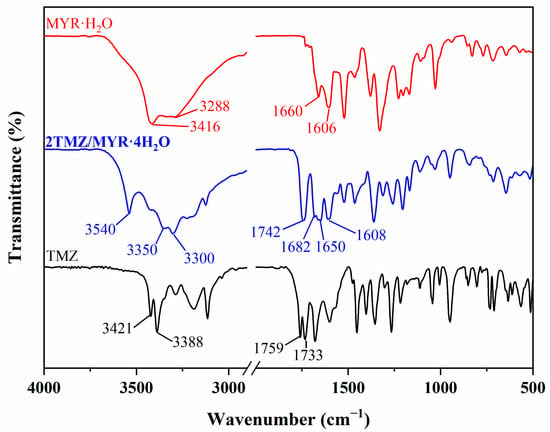
Figure 6.
FTIR spectra of TMZ, MYR·H2O, and 2TMZ/MYR·4H2O.
DVS Study. A DVS study of TMZ, MYR·H2O, and 2TMZ/MYR·4H2O was performed and the resulting vapor sorption/desorption isotherms are shown in Figure 7. PXRD tests were used to detect possible phase changes (Figure S4). The results showed that the cocrystal and MYR·H2O exhibited humidity-induced phase transitions, while TMZ remained stable across all relative humidity (RH) ranges. At 0% RH, both the cocrystal and MYR·H2O lost one water molecule, forming TMZ-MYR·3H2O and anhydrous MYR, respectively. Upon increasing RH to 10% and 20%, they absorbed one water molecule back and reverted to their original hydrated forms, demonstrating reversible water adsorption/desorption. Among the four water molecules in the cocrystal, one (O15 in Figure 2a) only forms hydrogen bonds with the other two water molecules and lacks strong hydrogen bonding interactions with MYR or TMZ. This weaker interaction profile makes it more prone to desorption. The cocrystal is stable between 10% and 95% RH, making it suitable for pharmaceutical formulations.
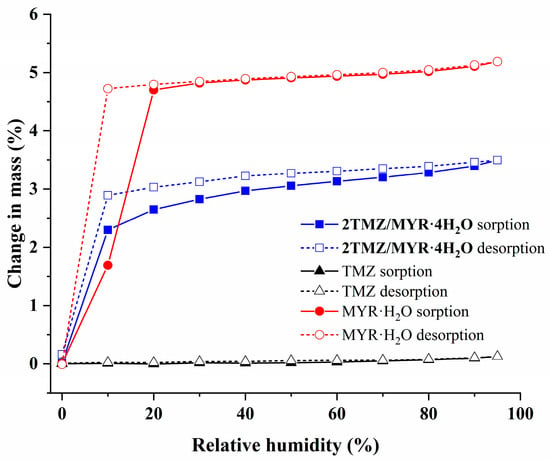
Figure 7.
Water sorption/desorption isotherms of TMZ, MYR·H2O, and 2TMZ/MYR·4H2O at 25 °C.
Accelerated Stability Study. Considering that TMZ is subject to stability issues, an accelerated stability study was conducted to evaluate the physical and chemical stability of the cocrystal and TMZ under stressed conditions (40 °C/75% RH). The cocrystal maintained its yellow crystalline appearance for 3 months, while pure TMZ showed signs of discoloration within 1 month (Figure S5). The cocrystal’s PXRD pattern remained unchanged throughout the study. In contrast, pure TMZ exhibited new degradation peaks at 2θ values of 11.6°, 12.9°, and 27.3° by the 2nd month, indicating crystalline phase changes (Figure S6). Additionally, the residual TMZ content in the cocrystal was 97.59 ± 0.14% after 3 months, significantly higher than that of pure TMZ (31.64 ± 0.64%) (Figure 8). These results confirm that the cocrystal retained its structural integrity under accelerated conditions, whereas TMZ underwent degradation as previously reported []. Compared to previous study on TMZ-flavonoid cocrystals, 2TMZ/MYR·4H2O demonstrates comparable or superior stability. For example, the TMZ-hesperetin cocrystal retained 95.3% of TMZ after 3 months under similar conditions [], whereas the present cocrystal maintains 97.59% TMZ content, highlighting the unique stabilizing effect of MYR. The cocrystal’s improved stability can be attributed to its 3D hydrogen-bonded network, which restricts molecular mobility and shields labile functional groups by disrupting the self-assembled reticular framework of TMZ (Figure S1). This structural arrangement effectively suppresses TMZ decomposition.
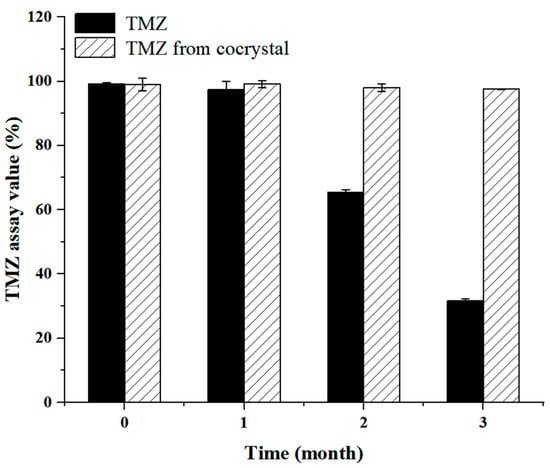
Figure 8.
Changes in TMZ assay values of pure TMZ and the cocrystal during storage under 40 °C/ 75% RH (n = 3).
Compaction Property. Compaction properties of the cocrystal, pure TMZ, and MYR·H2O were evaluated by powder compaction experiments. Figure S7 shows typical tablets of each sample compressed at 300 MPa. Under a compression pressure of up to 300 MPa, TMZ powder cannot form intact tablets, showing tablet lamination and capping. In contrast, MYR·H2O and 2TMZ/MYR·4H2O powders can be made into intact tablets throughout the entire compaction pressure range, demonstrating significantly improved compression performance. Additionally, these tablets remained intact after 24 h of relaxation, with no signs of lamination or capping.
The tabletability profiles of the three powdered samples from 50 MPa to 300 MPa are shown in Figure 9. For the cocrystal and MYR·H2O, tensile strength increased with compaction pressure, reaching the pharmaceutical tablet threshold (≥2 MPa) above 200 MPa []. They exhibited superior tabletability compared to pure TMZ. The compaction performance of the materials was correlated with their crystal structures [,]. The reticular interwoven framework of TMZ (Figure S1c) limits plastic deformation, leading to low tensile strength and poor tablet integrity. The cocrystal and MYR·H2O form 2D layered and wavy structures (Figure 2d,e and Figure S2c), with the existence of crystalline water molecules in their structures, which enhance plastic deformation and improve tabletability. Compared to other TMZ-flavonoid cocrystals, 2TMZ/MYR·4H2O shows better tabletability []. PXRD analysis of the compacted samples revealed no phase transitions of the cocrystal or MYR·H2O under 300 MPa (Figure S8), which is crucial for maintaining drug efficacy in tablet formulations.
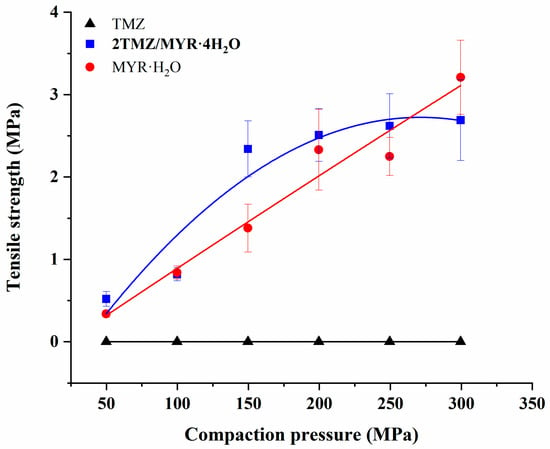
Figure 9.
Tabletability of TMZ, MYR∙H2O, and 2TMZ/MYR·4H2O (n = 3).
Dissolution Study. A dissolution study was conducted to evaluate the solubility and release profiles of TMZ and MYR from the cocrystal, compared to their pure forms. The cocrystal showed an improved MYR dissolution rate while TMZ release from the cocrystal was delayed compared to pure TMZ (Figure 10). The maximum apparent solubility (Smax) of MYR in the cocrystal was 176.4 μg/mL, significantly higher than that of pure MYR·H2O (26.9 μg/mL)—an approximately 6.6-fold increase. The cocrystal’s hydrogen-bonded 3D network weakens the intermolecular interactions of MYR itself, facilitating solvent penetration and dissolution. Like other TMZ-flavonoid cocrystals, 2TMZ/MYR·4H2O also shows superior MYR solubility enhancement [,]. This enhancement may address MYR’s low bioavailability, which is typically limited by its poor water solubility. TMZ solubility from the cocrystal (786.7 μg/mL) was remarkably lower than that of pure TMZ (7519.8 μg/mL). The reduction in TMZ solubility can be attributed to the formation of the cocrystal between TMZ and hydrophobic MYR, which reduces TMZ’s affinity for aqueous media, resulting in a slower yet more controlled release profile. The solubility gap between TMZ and MYR was drastically reduced from ~280-fold (in pure forms) to ~4.5-fold in the cocrystal. This balance in release profiles is critical for synergistic anti-glioma therapy, as it ensures concurrent availability of both drugs. In contrast, physical mixtures exhibit mismatched release kinetics, limiting their clinical efficacy. Following the powder dissolution experiment, the crystal phases of the residual solids were analyzed. TMZ was found to transform into TMZ·H2O, whereas the crystal phase of MYR·H2O remained unchanged. In the 2TMZ/MYR·4H2O cocrystal, the diffraction peak corresponding to MYR·H2O emerged, which can be ascribed to the dissociation of the two components in the dissolution medium. Given the poor solubility of MYR·H2O and the good solubility of TMZ, excess MYR·H2O precipitated, leading to the appearance of its peaks in the sample (Figure S9).
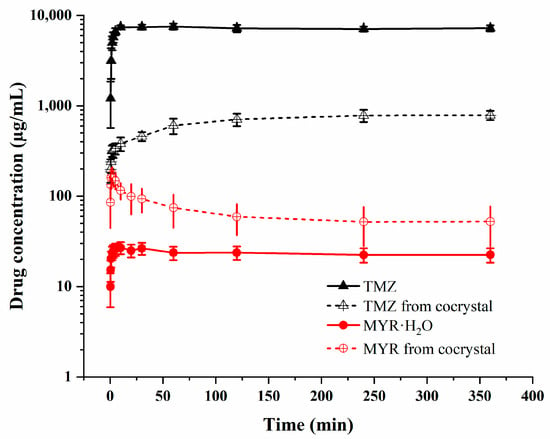
Figure 10.
Powder dissolution profiles of TMZ, MYR∙H2O, and the cocrystal (n = 3).
4. Conclusions
In this study, a novel drug-drug cocrystal hydrate of TMZ and MYR, denoted as 2TMZ/MYR·4H2O, was successfully prepared via slurry and solvent evaporation techniques. The cocrystal was fully characterized using XRD, TG, DSC, FTIR, and DVS measurements. Crystal structure analysis revealed that the cocrystal lattice contained two TMZ molecules, one MYR molecule, and four water molecules, which were linked by hydrogen bonding interactions to produce a 3D network. Property evaluations demonstrated significant improvements in the stability and tabletability of TMZ, as well as the enhancement of solubility of MYR, and the delayed dissolution behavior of TMZ. In summary, the cocrystal represents a promising strategy for synergistic anti-glioma therapy, combining the therapeutic effects of TMZ and MYR while overcoming their individual limitations.
Supplementary Materials
The following supporting information can be downloaded at: https://www.mdpi.com/article/10.3390/pharmaceutics17070906/s1, Figure S1: (a) Dimer, (b) ring-shaped node, and (c) reticular interlaced structure of TMZ crystal; Figure S2: (a) Top and (b) side view of 2D wavy structure, and (c) 3D structure of MYR∙H2O; Figure S3: Hirshfeld Surface 2D fingerprint plots of (a) TMZ, (b) MYR∙H2O, and (c) 2TMZ/MYR·4H2O; Figure S4: PXRD patterns of TMZ, MYR∙H2O, 2TMZ/MYR·4H2O before and after DVS measurements; Figure S5: Photographs of (a) TMZ and (b) 2TMZ/MYR·4H2O under 40 °C/75% RH at 0, 1, 2, and 3 months. Figure S6: PXRD patterns of (a) TMZ and (b) 2TMZ/MYR·4H2O under 40 °C/75% RH; Figure S7: Photographs of (a) TMZ, (b) MYR∙H2O, and (c) 2TMZ/MYR·4H2O tablets under compaction pressure of 300 MPa; Figure S8: PXRD patterns of MYR∙H2O and 2TMZ/MYR·4H2O before and after compaction experiments at 300 MPa; Figure S9: PXRD patterns of TMZ, MYR∙H2O, 2TMZ/MYR·4H2O before and after dissolution experiments; Table S1: The hydrogen bonding distances and angles of 2TMZ/MYR·4H2O.
Author Contributions
Conceptualization, T.-B.L. and J.-M.C.; Data curation, H.-X.Q., J.W. and J.-H.P.; Funding acquisition, J.-M.C.; Investigation, H.-X.Q., J.W. and J.-H.P.; Methodology, X.-L.D.; Supervision, J.-M.C.; Validation, X.-L.D. and C.-W.L.; Visualization, H.-X.Q., J.W. and J.-H.P.; Writing—original draft, H.-X.Q. and J.W.; Writing—review and editing, C.-W.L., T.-B.L. and J.-M.C. All authors have read and agreed to the published version of the manuscript.
Funding
This work was financially supported by the National Natural Science Foundation of China (No. 22271220) and Graduate Education and Teaching Research and Reform Project of Tianjin University of Technology (No. YBXM2321).
Institutional Review Board Statement
Not applicable.
Informed Consent Statement
Not applicable.
Data Availability Statement
The results obtained for all experiments performed are shown in the manuscript and Supplementary Materials, the raw data will be provided upon request.
Conflicts of Interest
The author Jie Wang is employed by the company Bionna (Beijing) Medicine Technology Co., Ltd. The remaining authors declare that the research was conducted in the absence of any commercial or financial relationships that could be construed as potential conflicts of interest.
References
- Aitipamula, S.; Banerjee, R.; Bansal, A.K.; Biradha, K.; Cheney, M.L.; Choudhury, A.R.; Desiraju, G.R.; Dikundwar, A.G.; Dubey, R.; Duggirala, N.; et al. Polymorphs, salts, and cocrystals: What’s in a name? Cryst. Growth Des. 2012, 12, 2147–2152. [Google Scholar] [CrossRef]
- Schultheiss, N.; Newman, A. Pharmaceutical Cocrystals and Their Physicochemical Properties. Cryst. Growth Des. 2009, 9, 2950–2967. [Google Scholar] [CrossRef] [PubMed]
- Thakuria, R.; Delori, A.; Jones, W.; Lipert, M.P.; Roy, L.; Rodríguez-Hornedo, N. Pharmaceutical cocrystals and poorly soluble drugs. Int. J. Pharm. 2013, 453, 101–125. [Google Scholar] [CrossRef] [PubMed]
- Rathi, R.; Singh, I.; Sangnim, T.; Huanbutta, K. Development and Evaluation of Fluconazole Co-Crystal for Improved Solubility and Mechanical Properties. Pharmaceutics 2025, 17, 371. [Google Scholar] [CrossRef] [PubMed]
- Deng, J.H.; Lu, T.B.; Sun, C.C.; Chen, J.M. Dapagliflflozin-citric acid cocrystal showing better solid state properties than dapagliflflozin. Eur. J. Pharm. Sci. 2017, 104, 255–261. [Google Scholar] [CrossRef]
- Hiendrawan, S.; Veriansyah, B.; Widjojokusumo, E.; Soewandhi, S.N.; Wikarsa, S.; Tjandrawinata, R.R. Physicochemical and mechanical properties of paracetamol cocrystal with 5-nitroisophthalic acid. Int. J. Pharm. 2016, 497, 106–113. [Google Scholar] [CrossRef]
- Dai, X.L.; Pang, B.W.; Lv, W.T.; Zhen, J.F.; Gao, L.; Li, C.W.; Xiong, J.; Lu, T.B.; Chen, J.M. Improving the physicochemical and pharmacokinetic properties of olaparib through cocrystallization strategy. Int. J. Pharm. 2023, 647, 123497. [Google Scholar] [CrossRef]
- Trask, A.V. An overview of pharmaceutical cocrystals as intellectual property. Mol. Pharm. 2007, 4, 301–309. [Google Scholar] [CrossRef]
- Thipparaboina, R.; Kumar, D.; Chavan, R.B.; Shastri, N.R. Multidrug co-crystals: Towards the development of effective therapeutic hybrids. Drug Discov. Today 2016, 21, 481–490. [Google Scholar] [CrossRef]
- Boycov, D.E.; Drozd, K.V.; Manin, A.N.; Churakov, A.V.; Vlasov, M.Y.; Kachalkina, I.V.; Perlovich, G.L. Novel Drug–Drug Cocrystalline Forms of Carbamazepine with Sulfacetamide: Preparation, Characterization, and In Vitro/In Vivo Performance Evaluation. Pharmaceutics 2025, 17, 678. [Google Scholar] [CrossRef]
- Wang, X.J.; Du, S.Z.; Zhang, R.; Jia, X.D.; Yang, T.; Zhang, X.J. Drug-drug cocrystals: Opportunities and challenges. Asian J. Pharm. Sci. 2021, 16, 307–317. [Google Scholar] [CrossRef] [PubMed]
- Karachi, A.; Dastmalchi, F.; Mitchell, D.A.; Rahman, M. Temozolomide for immunomodulation in the treatment of glioblastoma. Nruro. Oncol. 2018, 20, 1566–1572. [Google Scholar] [CrossRef] [PubMed]
- Jatyan, R.; Singh, P.; Sahel, D.K.; Karthik, Y.G.; Mittal, A.; Chitkara, D. Polymeric and small molecule-conjugates of temozolomide as improved therapeutic agents for glioblastoma multiforme. J. Control. Release 2022, 350, 494–513. [Google Scholar] [CrossRef] [PubMed]
- Advanced Chemistry Development, Inc. (ACD/Labs). Available online: https://www.acdlabs.com/products/percepta-platform/ (accessed on 9 July 2025).
- Babu, N.J.; Sanphui, P.; Nangia, A. Crystal engineering of stable temozolomide cocrystals. Chem.–Asian J. 2012, 7, 2274–2285. [Google Scholar] [CrossRef]
- Hammond, L.A.; Eckardt, J.R.; Baker, S.D.; Eckhardt, S.G.; Dugan, M.; Forral, K.; Reidenberg, P.; Statkevich, P.; Weiss, G.R.; Rinaldi, D.A.; et al. Phase I and pharmacokinetic study of Temozolomide on a daily-for-5-days schedule in patients with advanced solid malignancies. J. Clin. Oncol. 1999, 17, 2604–2613. [Google Scholar] [CrossRef]
- Attari, Z.; Rao, C.M.; Kumar, L.; Koteshwara, K.B. Temozolomide and its stability-a critical factor. Adv. Sci. Lett. 2017, 23, 1841–1845. [Google Scholar] [CrossRef]
- Li, J.M.; Dai, X.L.; Li, G.J.; Lu, T.B.; Chen, J.M. Constructing anti-glioma drug combination with optimized properties through cocrystallization. Cryst. Growth Des. 2018, 18, 4270–4274. [Google Scholar] [CrossRef]
- Wang, J.; Dai, X.L.; Lu, T.B.; Chen, J.M. Temozolomide–hesperetin drug–drug cocrystal with optimized performance in stability, dissolution, and tabletability. Cryst. Growth Des. 2021, 21, 838–846. [Google Scholar] [CrossRef]
- do Nascimento, R.P.; dos Santos, B.L.; Amparo, J.A.O.; Soares, J.R.P.; Santana, M.R.; Almeida, A.M.A.N.; da Silva, V.D.A.; Costa, M.D.D.; Ulrich, H.; Moura-Neto, V.; et al. Neuroimmunomodulatory Properties of Flavonoids and Derivates: A Potential Action as Adjuvants for the Treatment of Glioblastoma. Pharmaceutics 2022, 14, 116. [Google Scholar] [CrossRef]
- Siegelin, M.D.; Gaiser, T.; Habel, A.; Siegelin, Y. Daidzein overcomes TRAIL-resistance in malignant glioma cells by modulating the expression of the intrinsic apoptotic inhibitor, bcl-2. Neurosci. Lett. 2009, 454, 223–228. [Google Scholar] [CrossRef]
- Zhu, S.; Yuan, H.S.; Alahmadi, T.A.; Almoallim, H.S.; Wang, C.L. Morin Inhibits Cell Proliferation and Induces Caspase-mediated Apoptotic Cell Death in Glioma C6 Cell Line. Pharmacogn. Mag. 2024, 20, 494–504. [Google Scholar] [CrossRef]
- Song, T.; Zhang, M.Y.; Wu, J.; Chen, F.H.; Wang, Y.; Ma, Y.J.; Dai, Z.J. Glioma progression is suppressed by Naringenin and APO2L combination therapy via the activation of apoptosis in vitro and in vivo. Investig. New Drugs 2020, 38, 1743–1754. [Google Scholar] [CrossRef] [PubMed]
- Zhao, H.F.; Wang, G.; Wu, C.P.; Zhou, X.M.; Wang, J.; Chen, Z.P.; Du, C.S.; Li, W.P. A multi-targeted natural flavonoid myricetin suppresses lamellipodia and focal adhesions formation and impedes glioblastoma cell invasiveness and abnormal motility. CNS Neurol. Disord. Drug Targets 2018, 17, 557–567. [Google Scholar] [CrossRef]
- Wang, F.R.; Jiang, Y.S. Effect of treatment with baicalein on the intracerebral tumor growth and survival of orthotopic glioma models. J. Neuro-Oncol. 2015, 124, 5–11. [Google Scholar] [CrossRef] [PubMed]
- Li, Q.; Miao, Z.W.; Wang, R.; Yang, J.; Zhang, D.B. Hesperetin induces apoptosis in human glioblastoma cells via p38 MAPK activation. Nutr. Cancer 2020, 72, 538–545. [Google Scholar] [CrossRef]
- Mureşan-Pop, M.; Pop, M.M.; Borodi, G.; Todea, M.; Nagy-Simon, T.; Simon, S. Solid dispersions of Myricetin with enhanced solubility: Formulation, characterization and crystal structure of stability-impeding Myricetin monohydrate crystals. J. Mol. Struct. 2017, 1141, 607–614. [Google Scholar] [CrossRef]
- Park, K.S.; Chong, Y.; Kim, M.K. Myricetin: Biological activity related to human health. Appl. Biol. Chem. 2016, 59, 259–269. [Google Scholar] [CrossRef]
- CrysAlisPro, ver.1.171.44.91a; Agilent Technologies Inc.: Santa Clara, CA, USA, 2014.
- Sheldrick, G.M. SHELXTL, ver. 97; Program for Crystal Structure Solution and Refinement; University of Gottingen: Gottingen, Germany, 1997.
- Lowe, P.R.; Sansom, C.E.; Schwalbe, C.H.; Stevens, M.F.G.; Clark, A.S. Antitumor imidazotetrazines. 25. Crystal structure of 8-carbamoyl-3-methylimidazo [5, 1-d]-1, 2, 3, 5-tetrazin-4 (3H)-one (temozolomide) and structural comparisons with the related drugs mitozolomide and DTIC. J. Med. Chem. 1992, 35, 3377–3382. [Google Scholar] [CrossRef]
- Ren, S.C.; Liu, M.Y.; Hong, C.; Li, G.W.; Sun, J.B.; Wang, J.Y.; Zhang, L.; Xie, Y. The effects of pH, surfactant, ion concentration, coformer, and molecular arrangement on the solubility behavior of myricetin cocrystals. Acta Pharm. Sin. B 2019, 9, 59–73. [Google Scholar] [CrossRef]
- Spackman, M.A.; Jayatilaka, D. Hirshfeld surface analysis. CrystEngComm 2009, 11, 19–32. [Google Scholar] [CrossRef]
- Laszcz, M.; Kubiszewski, M.; Jedynak, L.; Kaczmarska, M.; Kaczmarek, L.; Luniewski, W.; Gabarski, K.; Witkowska, A.; Kuziak, K.; Malinska, M. Identification and physicochemical characteristics of temozolomide process-related impurities. Molecules 2013, 18, 15344–15356. [Google Scholar] [CrossRef] [PubMed]
- Braverman, O.; Feishtein, R.; Weisman, A.; Kaspi, J. Temozolomide Storage System. U.S. Patent 0222792 A1, 5 October 2006. [Google Scholar]
- Perumalla, S.R.; Shi, L.; Sun, C.C. Ionized form of acetaminophen with improved compaction properties. CrystEngComm 2012, 14, 2389–2390. [Google Scholar] [CrossRef]
- Chattoraj, S.; Shi, L.; Sun, C.C. Understanding the relationship between crystal structure, plasticity and compaction behavior of theophylline, methyl gallate, and their 1:1 co-crystal. CrystEngComm 2010, 12, 2466–2472. [Google Scholar] [CrossRef]
- Krishna, G.R.; Shi, L.M.; Bag, P.P.; Sun, C.C.; Reddy, C.M. Correlation among crystal structure, mechanical behavior, and tabletability in the co-crystals of vanillin isomers. Cryst. Growth Des. 2015, 15, 1827–1832. [Google Scholar] [CrossRef]
Disclaimer/Publisher’s Note: The statements, opinions and data contained in all publications are solely those of the individual author(s) and contributor(s) and not of MDPI and/or the editor(s). MDPI and/or the editor(s) disclaim responsibility for any injury to people or property resulting from any ideas, methods, instructions or products referred to in the content. |
© 2025 by the authors. Licensee MDPI, Basel, Switzerland. This article is an open access article distributed under the terms and conditions of the Creative Commons Attribution (CC BY) license (https://creativecommons.org/licenses/by/4.0/).